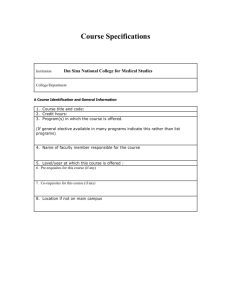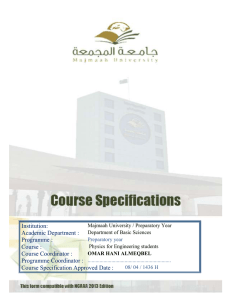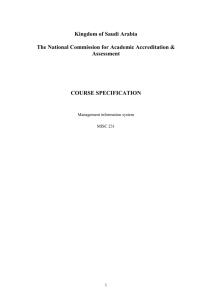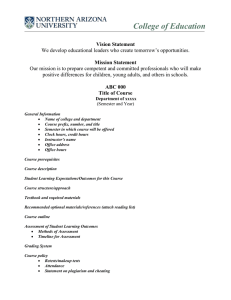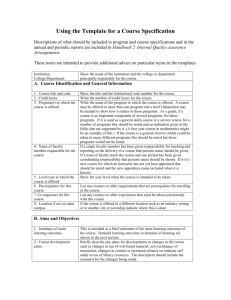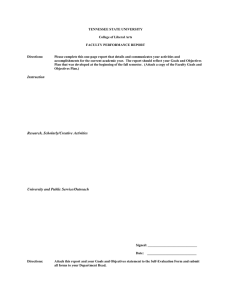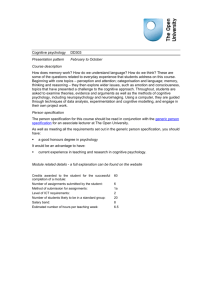Program specification
advertisement
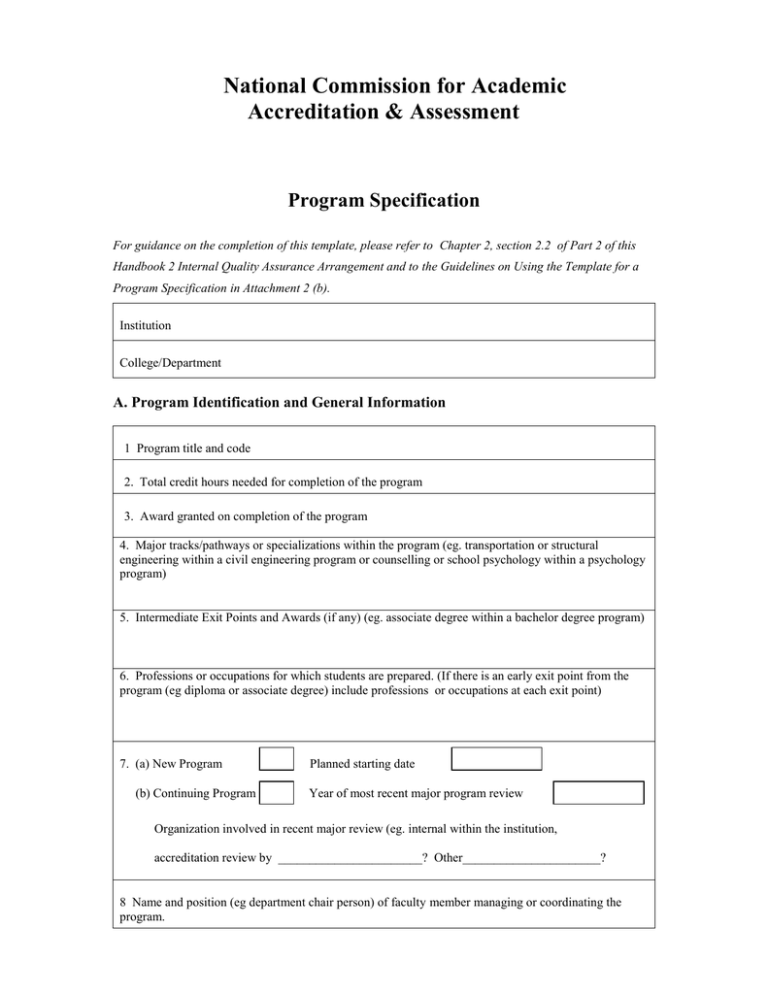
National Commission for Academic Accreditation & Assessment Program Specification For guidance on the completion of this template, please refer to Chapter 2, section 2.2 of Part 2 of this Handbook 2 Internal Quality Assurance Arrangement and to the Guidelines on Using the Template for a Program Specification in Attachment 2 (b). Institution College/Department A. Program Identification and General Information 1 Program title and code 2. Total credit hours needed for completion of the program 3. Award granted on completion of the program 4. Major tracks/pathways or specializations within the program (eg. transportation or structural engineering within a civil engineering program or counselling or school psychology within a psychology program) 5. Intermediate Exit Points and Awards (if any) (eg. associate degree within a bachelor degree program) 6. Professions or occupations for which students are prepared. (If there is an early exit point from the program (eg diploma or associate degree) include professions or occupations at each exit point) 7. (a) New Program (b) Continuing Program Planned starting date Year of most recent major program review Organization involved in recent major review (eg. internal within the institution, accreditation review by _______________________? Other______________________? 8 Name and position (eg department chair person) of faculty member managing or coordinating the program. 9. Location if not on main campus or locations if program is offered in more than one location. B Program Context 1 Explain why the program is needed. a. Summarize economic reasons, social or cultural reasons, technological developments, national policy developments or other reasons. b. Explain the relevance of the program to the mission of the institution. 2. Relationship (if any) to other programs offered by the institution/college/department. a. Does this program offer courses that students in other programs are required to take? Yes No If yes, what should be done to make sure those courses meet the needs of students in the other programs? b. Does the program require students to take courses taught by other departments? Yes No If yes, what should be done to make sure those courses in other departments meet the needs of students in this program? 3. Do the students who are likely to be enrolled in the program have any special needs or characteristics that should be considered in planning the program? (eg. Part time evening students, limited IT or language skills) Yes No If yes, what are they? 4. What should be done in the program to respond to these special characteristics? C. Mission and Goals of the Program 1 1. Program Mission Statement 2. List any major changes or strategic new developments planned for the program within the next three to five years to help achieve its mission. For each change or development describe the major strategies to be followed and list the indicators that will be used to measure achievement. Major Changes or Developments Strategies Indicators D. Program Structure and Organization 1 Program Description. A program or department manual should be available for students or other stakeholders and a copy of the information relating to this program should be attached to the program specification. This information should include required and elective courses, credit hour requirements and department/college and institution requirements, and details of courses to be taken in each year or semester. 2. Development of Special Student Characteristics or Attributes List any special student characteristics or attributes beyond normal expectations that the institution, college or department is trying to develop in all of its students. ( Normally one or two, up to a maximum of four that directly reflect the program mission and distinguish this program from others in the same field and make it exceptional. Eg. Graduates particularly good at creative problem solving, leadership capacity, commitment to public service, high level of skills in IT). For each special attribute indicate the teaching strategies and student activities to be used to develop it and the evidence to be used to assess whether it has been developed in all students. Special Attributes Strategies or Student Activities to be Used throughout the Program to Develop These Special Attributes Strategy Evidence Strategy Evidence Strategy 2 Evidence Strategy Evidence 3. Required Field Experience Component (if any) (Eg. internship, cooperative program, work experience) Summary of practical, clinical or internship component required in the program. Note that a more detailed Field Experience Specification comparable to a course specification should also be prepared in a separate document for any field experience required as part of the program. a. Brief description of field experience activity b. List the major intended learning outcomes for the program to be developed through the field experience c. At what stage or stages in the program does the field experience occur? (eg. year, semester) d. Time allocation and scheduling arrangement. (Eg. 3 days per week for 4 weeks, full time for one semester) e. Number of credit hours 4. Project or Research Requirements (if any) Summary of any project or thesis requirement in the program. (Other than projects or assignments within individual courses) (A copy of the requirements for the project should be attached.) a. Brief description b. List the major intended learning outcomes of the project or research task. c. At what stage or stages in the program is the project or research undertaken? (eg. year, semester) 3 d. Number of credit hours e. Summary description of provisions for student academic advising and support. f. Description of assessment procedures (including mechanism for verification of standards) 5. Development of Learning Outcomes in Domains of Learning For each of the domains of learning shown below indicate: The knowledge or skill the program is intended to develop and the level of that knowledge and skill. (as a guide see general descriptions of knowledge and skills in the National Qualifications Framework for the qualification level of this program; The teaching strategies to be used in courses in the program to develop that knowledge and those skills. (This should be a general description of the approaches taken throughout the program but if particular responsibility is to be assigned to certain courses this should be indicated.); The methods of student assessment to be used in courses n the program to evaluate learning outcomes in the domain concerned. a. Knowledge (i) Summary description of the knowledge to be acquired (ii) Teaching strategies to be used to develop that knowledge (iii) Methods of assessment of knowledge acquired 4 b. Cognitive Skills (i) Cognitive skills to be developed and level of performance expected (ii) Teaching strategies to be used to develop these cognitive skills (iii) Methods of assessment of students cognitive skills c. Interpersonal Skills and Responsibility (i) Description of the level of interpersonal skills and capacity to carry responsibility to be developed (ii) Teaching strategies to be used to develop these skills and abilities 5 (iii) Methods of assessment of students interpersonal skills and capacity to carry responsibility d. Communication, Information Technology and Numerical Skills (i) Description of the communication, IT and numerical skills to be developed (ii) Teaching strategies to be used to develop these skills (iii) Methods of assessment of students numerical and communication skills 6 e. Psychomotor Skills (if applicable) (i) Description of the psychomotor skills to be developed and the level of performance required (ii) Teaching strategies to be used to develop these skills (iii) Methods of assessment of students psychomotor skills 6. Admission Requirements for the program Attach handbook or bulletin description of admission requirements including any course or experience prerequisites. 7. Attendance and Completion Requirements Attach handbook or bulletin description of requirements for: a. Attendance. b. Progression from year to year. c. Program completion E. Regulations for Student Assessment and Verification of Standards 1. Regulations or policies for allocation and distribution of grades If the institution, college, department or program has policies or regulations dealing with the allocation or distribution of students grades state the policy or regulation, or attach a copy. 7 2. What processes will be used for verifying standards of achievement (eg check marking of sample of tests or assignments? Independent assessment by faculty from another institution) (Processes may vary for different courses or domains of learning. ) F Student Administration and Support 1. Student Academic Counselling Describe arrangements to be made for academic counselling and advice for students, including both scheduling of faculty office hours and advice on program planning, subject selection and career planning (which might be available at college level) 2. Student Appeals Attach regulations for student appeals on academic matters, including processes for consideration of those appeals. G. Text and Reference Material 1. What process is to be followed by faculty in the program for planning and acquisition of text, reference and other resource material including electronic and web based resources? 2. What processes are to be followed by faculty in the program for evaluating the adequacy of book, reference and other resource provision? 8 H. Faculty and other Teaching Staff 1. Appointments Summarize the process of employment of new teaching staff to ensure that they are appropriately qualified and experienced for their teaching responsibilities. 2. Participation in Program Planning, Monitoring and Review Explain the process for consultation with and involvement of teaching staff in monitoring program quality, annual review and planning for improvement. 3. Professional; Development What arrangements are made for professional development of teaching staff for: (a) Improvement of skills in teaching? (b) Other professional development including knowledge of research and developments in their field of teaching? 4. Preparation of New Teaching Staff Describe the process used for orientation and/or induction of new, visiting or part time teaching staff to ensure full understanding of the program and the role of the course(s) they teach as components within it. 9 5. Part Time and Visiting Teaching Staff Provide a summary of Program/Department/ College/institution policy on appointment of part time and visiting teaching staff. (ie. Approvals required, selection process, proportion of total teaching staff etc.) I. Program Evaluation and Improvement Processes 1. Effectiveness of Teaching a. What processes will be used to evaluate and improve the strategies planned for developing learning in the different domains of learning? (eg. assessment of learning achieved, advice on consistency with learning theory for different types of learning, assessment of understanding and skill of teaching staff in using different strategies) b. What processes will be used for evaluating the skills of teaching staff in using the planned strategies? 2. Overall Program Evaluation a. What strategies will be used in the program for obtaining assessments of the overall quality of the program and achievement of its intended learning outcomes: (i) from current students and graduates of the program? 10 (ii) from independent advisors and/or evaluator(s)?. (iii) from employers and/or other stakeholders. b. What key performance indicators will be used to monitor and report annually on the quality of the program? c. What processes will be followed for reviewing these assessments and planning action to improve the program? Attachments. 1. Copies of regulations and other documents referred to in template preceded by a table of contents. 2. Course specifications for all courses including field experience specification if applicable. 11 Allocation of Responsibilities for Learning Outcomes to Courses Learning Outcomes Courses Course Code and Number Knowledge Facts Concepts, theories Procedures Cognitive Skills Apply skills when asked Creative thinking and problem solving Interpersonal Skills and Responsibility Responsibility for own learning Group participation and leadership Act responsibly-personal and professional situations Ethical standards of behavior Communication IT and Numerical Skills Oral and written communication Use of IT Basic maths and statistics Psychomotor Skills √ Major Responsibility x Minor Responsibility (Note: Add additional sheets if necessary to provide for all required courses in the program including any courses offered by other departments) 12 13
